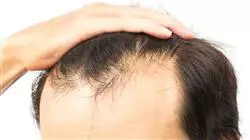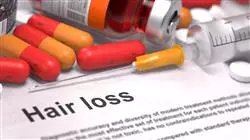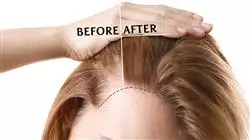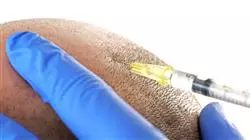University certificate
The world's largest faculty of medicine”
Why study at TECH?
The best program on the current academic market to implement in your clinical practice the most effective and innovative alternative treatments in hair dermatology based on natural products’’

Trichology has taken on special relevance in recent years, not only because of the increase in demand related to hair transplant treatments and the clinical management of various diseases affecting the scalp, but also because of the increasingly effective and promising results that have been obtained over time. In the vast majority of cases, patients come to the specialist's office because of the negative aesthetic impact they believe they are causing, which is why their self-esteem and, therefore, their psychosocial development are significantly diminished.
For this reason, up-to-date knowledge of the diagnostic and therapeutic guidelines related to this area of dermatology must be one of the priorities for the professional. Based on this, and in order to facilitate your update, TECH has developed the Postgraduate diploma in Hair Transplantation Consultation and Surgery. Cosmetic & Medical Treatments, a complete program that contemplates the most exhaustive and innovative information in 450 hours of 100% online academic program. Thanks to this program, the graduate will be able to perfect their skills in medical-surgical assistance, implementing in their practice the therapeutic strategies that have had the best results to date, including the best chemical and natural drugs for the different pathologies.
In addition, the professional will have the support of a teaching team of the highest level, which, in addition to being at their disposal to resolve any doubts that may arise during the course of the program, has actively participated in the design of the program content. It includes, in addition to a comprehensive and up-to-date syllabus, clinical cases based on real situations and additional multidisciplinary material to learn in a personalized way in the different sections. Thus, you will have an academic program that adapts to your needs.
You will work with the most complete and up-to-date information related to examination methods in the diagnostic medical office’’
This Postgraduate diploma in Hair Transplantation Consultation and Surgery. Cosmetic & Medical Treatments contains the most complete and up-to-date scientific program on the market. The most important features include:
- Practical cases presented by experts in Dermatology and Hair Transplantation
- The graphic, schematic, and practical contents with which they are created, provide scientific and practical information on the disciplines that are essential for professional practice
- Practical exercises where self-assessment can be used to improve learning
- Its special emphasis on innovative methodologies
- Theoretical lessons, questions to the expert, debate forums on controversial topics, and individual reflection assignments
- Content that is accessible from any fixed or portable device with an
Internet connection
Would you like to get up to date on hair grafting tools for extraction? This program includes a detailed catalog of the most innovative ones, with their characteristics, advantages, recommendations, etc’’
The program’s teaching staff includes professionals from the sector who contribute their work experience to this educational program, as well as renowned specialists from leading societies and prestigious universities.
The multimedia content, developed with the latest educational technology, will provide the professional with situated and contextual learning, i.e., a simulated environment that will provide immersive education programmed to learn in real situations.
This program is designed around Problem-Based Learning, whereby the professional must try to solve the different professional practice situations that arise during the academic year. For this purpose, the student will be assisted by an innovative interactive video system created by renowned and experienced experts.
A program thanks to which you will be able to improve your practice in relation to the pre-surgical management of the patient before hair transplantation"

You will have unlimited access to a state-of-the-art Virtual Campus which you can access from any device with an internet connection, whether it is a PC, tablet or cell phone"
Syllabus
The 450 hours of content included in this Postgraduate diploma have been designed by the teaching team based on two fundamental pillars: the most exhaustive and innovative information related to cosmetic and medical treatments in Hair Dermatology and the innovative Relearning methodology. Thanks to this, it has been possible to develop a dynamic, complete and avant-garde program, which will make it easier for the graduate to keep up to date. In addition, its convenient online format will allow you to access your course from wherever and whenever you want, being able to combine it perfectly with the activity of your practice.

The program includes dozens of hours of in-depth videos, research articles, supplemental readings, self-awareness exercises, dynamic summaries and much more additional material!’’
Module 1. Medical Care/Consultation and Surgery
1.1. Diagnostic Medical Consultation
1.1.1. Exploration Methods
1.1.1.1. Visual
1.1.1.2. Optical Microscope
1.1.1.3. Digital Microcameras
1.1.1.4. Micrometer
1.1.1.5. Wood Light
1.1.1.6. Traction Tweezers
1.1.1.7. Cigarette Paper
1.1.2. Performing a Trichogram
1.1.3. Dermographic Study
1.1.4. Traction Test
1.1.5. Wood Light
1.1.6. Biopsy (If Required)
1.1.7. Specific Blood Test
1.1.8. Photography
1.2. Pre-Surgical Medical Consultation
1.2.1. Medical History of Interest
1.2.2. Photography
1.2.3. Medical Consent
1.2.4. Patient Expectations
1.2.5. Surgical Plan
1.2.6. Pre-Op Instructions
1.2.7. Confirmation of Surgical Suitability
1.2.8. Post-Op Instructions
1.2.9. Surgical Alternatives and Other Treatments
1.3. Hair Transplant Devices
1.3.1. Hair Grafting Tools for Extraction
1.3.1.1. Punch or Circular Scalpel
1.3.1.2. SAFE Systems
1.3.1.3. RotoCore
1.3.1.4. NeoGraft® Automated FUE and Implantation System
1.3.2. Hair Grafting Tools for Implantation
1.3.2.1. Implanter
1.3.2.1.1. Advantages
1.3.2.1.2. Disadvantages
1.3.2.2. Making Incisions
1.3.2.2.1. Advantages
1.3.2.2.2. Disadvantages
1.3.3. Instruments for Making Incisions:
1.3.3.1. Sharp Points
1.3.3.2. Needles
1.3.3.3. Mini Blades
1.3.4. Main Developments
1.3.4.1. Extractor Machine with 0.7 mm Punch
1.3.4.2. Special Blades for Cutting and Trimming Follicular Units with the Strip
1.3.4.3. High-Resolution Microscope
1.3.4.4. 3-5x Magnifiers
1.3.4.5. 0.8-1.3 Angled Blades
1.3.4.6. 0.8mm and 1mm Implanters
1.3.5. Automated Extraction Systems - Hair Implantation
1.3.5.1. Automatic: Extraction
1.3.5.2. Semi-Automatic: Extraction and Implantation
1.4. Aesthetic Eyebrow Procedures
1.4.1. Indications
1.4.2. Diagnosis
1.4.3. Etiology Treatment
1.4.4. Most Common Procedures
1.4.4.1. Recreating the Eyebrow Curve
1.4.4.2. Hair Density Recovery
1.4.4.3. Correcting Drooping Eyebrows
1.4.5. Postoperative Care
1.4.6. Anesthesia in Capillary Surgery
1.4.6.1. Pre-Operative Study
1.4.6.2. EKG and Chest X-Ray
1.4.6.3. Pre-Medication
1.4.6.4. Oral Sedation Model
1.4.6.4.1. Stomach Protector
1.4.6.4.2. Oral Antiemetic
1.4.6.4.3. Oral Dormicum 7.5mg 1 Hour before Surgery
1.5. Intravenous Options
1.5.1. Venous Route
1.5.2. Antiemetics
1.5.3. Administer Dormicum (2mg) and Fentanest (50 mg)
1.5.4. Portable Pulse Oximetry without the Need for Cardiac Monitoring
1.5.5. Annexate and Naloxone Availability
1.6. Types of Anesthetics
1.6.1. Ester Type: Tetracaine, Chlorprocaine, Benzocaine, and Procaine
1.6.2. Amide Type: Lidocaine, Mepivacaine, Prilocaine, Bupivacaine, Ropivacaine, and Etidocaine
1.7. Factors Influencing its Action
1.7.1. Its Anesthetic Potency is Related to Liposolubility in a Directly Proportional Way
1.7.2. Vasodilation Capability
1.7.3. Plasma Protein Binding
1.7.4. Addition of a Vasoconstrictor, such as Adrenaline or Phenylephrine, Increases the Effect
1.7.5. Adrenaline Dosage Should Not Exceed 250mg in Adults
1.7.6. Alkalinization Improves Diffusion and Promotes Latency
1.7.7. Solution Heating Improves Blocking
1.7.8. Complications
1.7.8.1. Local Anesthesia Allergy
1.7.8.2. Local Anesthesia Toxicity
1.8. Non-Medical Team
1.8.1. Nursing
1.8.1.1. Functions
1.8.1.1.1. Assisting the Physician in Surgery
1.8.1.1.2. Extracting Follicular Units
1.8.1.1.3. Graft Trimming and Cleaning
1.8.1.1.4. Implanting Micrografts
1.8.2. Capillary Technician
1.8.2.1. Functions
1.8.2.1.1. Assisting the Nurse
1.8.2.1.2. Preparing the Room
1.8.2.1.3. Graft Trimming and Cleaning
1.8.2.1.4. Implanting Micrografts
1.8.2.1.5. Sterilization and Cleaning of the Room and Equipment
1.9. Complications/Emergencies in Surgery
1.10. Post-Surgery Treatment
1.10.1. Post-Operative Medication
1.10.2. Keep the Graft Site Clean and Hydrated
1.10.3. Sleep in a Half-Seated Position (10º/15º)
1.10.4. Avoid Sun Exposure
1.10.5. Minimal Physical Exercise
1.10.6. Apply Cold to the Face
Module 2. Cosmetic Treatments/Hair Cosmetics
2.1. Hair Cosmetics Definition. Concept. Materials Used
2.2. Hair Prosthesis. Definition. Differences between Male and Female
2.2.1. Manufacturing Materials
2.2.1.1. From the Outside of the Prosthesis: Different Types of Human Hair. Synthetic Hair
2.2.1.2. From the Inside of the Prosthesis: Tulle, Gauze, Mesh, Plasticized
2.2.2. Manufacturing Techniques
2.2.2.1. Choppy Hair
2.2.2.2. Woven Hair
2.2.3. Fastening Materials
2.2.3.1. Self-Adhesives
2.2.3.2. Glues or Adhesives
2.2.3.3. Stitched
2.2.4. Importance of Hair Prosthesis Maintenance
2.3. Micropigmentation
2.3.1. Micropigmentation Techniques
2.3.1.1. Capillary
2.3.1.2. Eyebrows
2.3.1.3. Beard
2.3.2. Aspects to Consider when Applying Hair Micropigmentation
2.3.3. Products Used in Hair Micropigmentation
2.3.4. Equipment Used in Hair Micropigmentation
2.3.5. Micropigmentation Preservation
2.4. Hair Fibers
2.4.1. Spray
2.4.2. Powder
2.5. Definition of Cosmetic Treatments
2.5.1. Limitations of Cosmetic Treatments
2.6. Cosmetic Penetration
2.6.1. Penetration Routes
2.6.2. Degrees of Penetration
2.6.3. Penetration Factors
2.7. General Composition of Cosmetics Active Ingredients, Excipients, Coloring, Perfume, Preservatives, Correcting Agents
2.7.1. Active ingredients
2.7.1.1. Plant: Origin, Procurement, and Composition
2.7.1.2. Animal: Origin, Procurement, and Composition
2.7.1.2.1. Synthetic: Origin, Procurement, and Composition
2.7.1.2.2. Others: Vitamins and Trace Elements
2.7.1.2.3. Excipients
2.7.1.2.4. Dyes
2.7.1.2.5. Perfumes
2.7.1.2.6. Preservatives
2.7.1.2.7. Correctors
2.8. Cosmetic Used in Hair Treatments
2.8.1. Dry Hair Cosmetics
2.8.2. Oily and Seborrheic Cosmetics
2.8.3. Pityriasis Cosmetics
2.8.4. Alopecia Cosmetics
2.9. Cosmetic Forms of Hair Treatments
2.9.1. Shampoos
2.9.2. Lotions
2.9.3. Peeling and Nourishing Masks
2.9.4. Micronutrients
2.10. Appliances Used in Cosmetic Treatments
2.10.1. Electrotherapy
2.10.2. High Frequency
2.10.3. Phototherapy
2.10.3.1. Infrared
2.10.3.2. Ultraviolet
2.10.3.3. Cosmetic Laser
2.10.4. Steamers
2.10.5. Vibrators
2.11. Hair Massage
2.11.1. Application Techniques
2.12. Treating Cancer Patients
2.12.1. Oncology Patient Quality of Life and Aesthetic Hair Medicine. The Healing Power of Image
2.12.2. Tests before Procedures in Oncology Patients
2.12.3. Intervention of the Aesthetic Practitioner Before, During, and After Oncological Treatment
2.12.4. Cancer Patient Micronutrition
Module 3. Medical/Pharmacological Treatments and Research in Trichology and New Treatment Alternatives
3.1. Oral Minoxidil (Rogaine®) vs. Topical Minoxidil
3.1.1. Antihypertensive
3.1.2. Available in 2% and 5% Solutions
3.1.3. Desired Effects: Vasodilation, Angiogenesis, and Enhanced Cell Proliferation
3.1.4. Side Effects: Contact Dermatitis and Temporary Hair Loss during the First Four Months of Use
3.1.5. Minoxidil 5% Foam Does Not Contain Propylene Glycol (potential irritant) and Lowers the Incidence of Pruritis
3.2. Oral Dutasteride (Avodart ®): Effectiveness and Safety
3.2.1. Dihydrotestosterone Production Inhibitor for the Treatment of Benign Prostatic Hyperplasia (BPH)
3.2.2. Dutasteride efficacy at 2.5 mg/day
3.2.3. Side Effects
3.3. Finasteride (Propecia®): Most Common for Male Pattern Baldness
3.3.1. A Reductase Inhibitor that Reduces the Conversion of Testosterone to Di-Hydrotestosterone or DHT Better than Finasteride
3.3.2. More Effective Equal Safety for Men and Women
3.3.3. Women: Avoid Pregnancy during Treatment and 3 Months After. It Is Not Officially Approved for Use in Women
3.3.3.1. Combination with an Effective Oral Contraceptive
3.3.4. Finasteride Safety vs. Dutasteride
3.3.5. Dutasteride Microinjections
3.3.6. Improved Hair Quantity and Thickness
3.3.7. Progress Over Time: 3 Months to 1 Year
3.3.8. Daily dose: 1mg
3.3.9. Problems of a Sexual Nature
3.4. 2% Ketoconazole Topical Shampoo (Nizoral ®)
3.4.1. Antifungal Agent
3.4.2. Treatment for Dermatitis and Dandruff
3.4.3. Action on Scalp Microflora
3.4.4. Beneficial Effect on Androgenetic Alopecia Associated with Hair Follicle Inflammation
3.5. Dexamethasone Minipulse Therapy (alopecia areata): Risks vs. Continuous Corticosteroids
3.6. JAK Inhibitor Drugs (Alopecia Areata)
3.6.1. Clinical Trials: Ruxolitinib or Tofacitinib (Extensive Alopecia Areata)
3.6.2. Efficacy and Safety Results
3.7. Anti-Androgens (Frontal Fibrosing Alopecia): Finasteride and Oral Dutasteride in Females with Frontal Fibrosing Alopecia
3.7.1. Loss of Eyebrows and Hair in the Frontal and Temporal Region ("Headband Area")
3.7.2. Block the Binding of Androgen Receptor to Testosterone
3.7.3. Cyproterone Acetate and Spironolactone
3.8. Prostaglandin Analogs
3.8.1. Lipidic Substances Derived from 20-Carbon Fatty Acids (Eicosanoids)
3.8.2. They Affect and Act on Different Systems of the Organism: Nervous System, Smooth Muscle, Blood and Reproductive System
3.8.3. They Regulate Various Functions: Blood Pressure, Blood Coagulation, the Allergic Inflammatory Response and the Activity of the Digestive System
3.8.4. Bimatoprost (Latisse®) is now available as a treatment for eyelash growth
3.8.5. Latanoprost Increases Hair Density and May Increase Pigmentation
3.9. Estrogens
3.9.1. Indirect Anti-Androgens
3.10. Capillary Cloning
3.10.1. Future Therapies. Unlimited Follicles from Hair Stem Cells. Human Clinical Trials
3.10.2. Two main approaches under investigation: direct injection of cultured cells or the use of factors that promote cell multiplication
3.10.3. Cells are cultured and the culture supernatant is processed to produce a rich compound to promote hair growth
3.10.4. PRP: Biostimulation Techniques
3.10.4.1. Increase the Number of Blood Vessels and Improve Circulation
3.10.4.2. Promote the Production of Collagen
3.10.4.3. Counteract the Negative Effect of Free Radicals and Prevent Cellular Aging
3.10.4.4. In Spain and According to the Resolution of the Spanish Agency of Medicines and Health Products (AEMPS) of May 23, 2013, the Materials and Methods are Restricted to the Use of Closed Techniques
3.11. Hair Transplantation with Micrografts in Men and Women
3.11.1. Robots Capable of Automated Extraction
3.12. Low Power Laser
3.12.1. Different Wavelengths and Different Modes
3.12.2. Low-Level Laser Intensive (LLLI) Laser Therapy
3.12.3. Uses: Female Androgenetic Alopecia and/or MAGA Male Androgenetic Alopecia. Treatments in Monotherapy or as Combined Therapies
3.12.4. Penetrates the Surface of the Skin. Stimulates Blood Flow. Helps Nutrients, Blood, and Oxygen Reach Hair Follicles
3.12.5. Hair Revitalization, Elimination of Toxins and Any Blockages Found Within the Follicle
3.13. Alternative Treatments
3.13.1. Herbs, Vitamins, and Minerals
3.13.2. Biotin, Caffeine, Melatonin, Copper Complexes
3.14. Considerations
3.14.1. Minoxidil and Finasteride Must be Used Continuously for Results and Once Discontinued, the Natural Baldness Process Resumes
3.14.2. PG Analogs Have a Much More Potent and Longer Lasting Effect, Although Not Permanent
3.14.3. Prostaglandin F2 Alpha Analogs Latanoprost and Bimatoprost are Used in the Treatment of Ocular Hypertension and Glaucoma

A unique, key, and decisive training experience to boost your professional development”
Postgraduate Diploma in Hair Transplant: Consultation and Surgery. Cosmetic and Medical Treatments
Among the most innovative procedures in medicine today is the hair transplant; a technique that is in great demand due to the severe hair loss problems that some people have. Although this is an innovative treatment, it should be performed only by trained personnel, since it requires unique skills that only trained specialists can perform. This is why at TECH we have designed a Postgraduate Diploma in Hair Transplant: Consultation and Surgery. Cosmetic and Medical Treatments which, in addition to providing students with the necessary guidelines to properly perform this procedure, covers the medical knowledge necessary to treat the patient from the first visit, to the trichological analysis and surgical intervention. In the extensive syllabus offered by this program, taught in 100% online mode, students will find the concepts of visagism applied to hair esthetics and the most common problems in a micrografting intervention on the scalp. They will also analyze the devices for hair transplantation, the use of the different local anesthetics, their pharmacokinetic characteristics and doses, followed by the different loco-regional blocks at facial and peripheral level.
Specialize in performing hair transplant procedures.
At TECH we use a unique methodology that will prepare you to respond assertively to any unforeseen situation that may arise; therefore, in our learning system we include the development of simulated clinical cases that will contribute to improve your resolution and performance skills. The program's syllabus, carefully designed by our teaching team, offers a series of indispensable tools for students to carry out an adequate management in surgical and post-surgical treatments; in this way, they will be able to guarantee that the intervention will be successful and without complications. At the end of the six months of training, the professionals will be experts in applying the main medical-aesthetic and alternative treatments currently available; these range from platelet-rich plasma, capillary mesotherapy and low-power laser (LLLT), to procedures with PRP, stem cells, androgens and estrogens. They will also learn about oral supplementation, dexamethasone minipulse therapy and pharmacological treatments with minoxidil, finasteride, dutasteride and anti-JAK.







